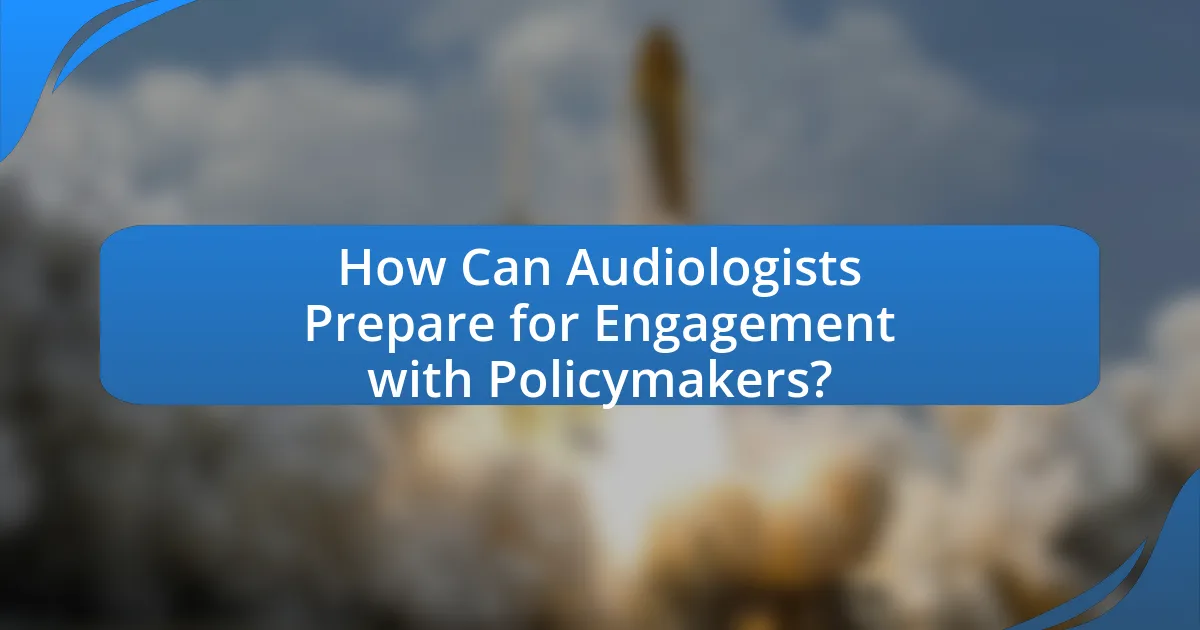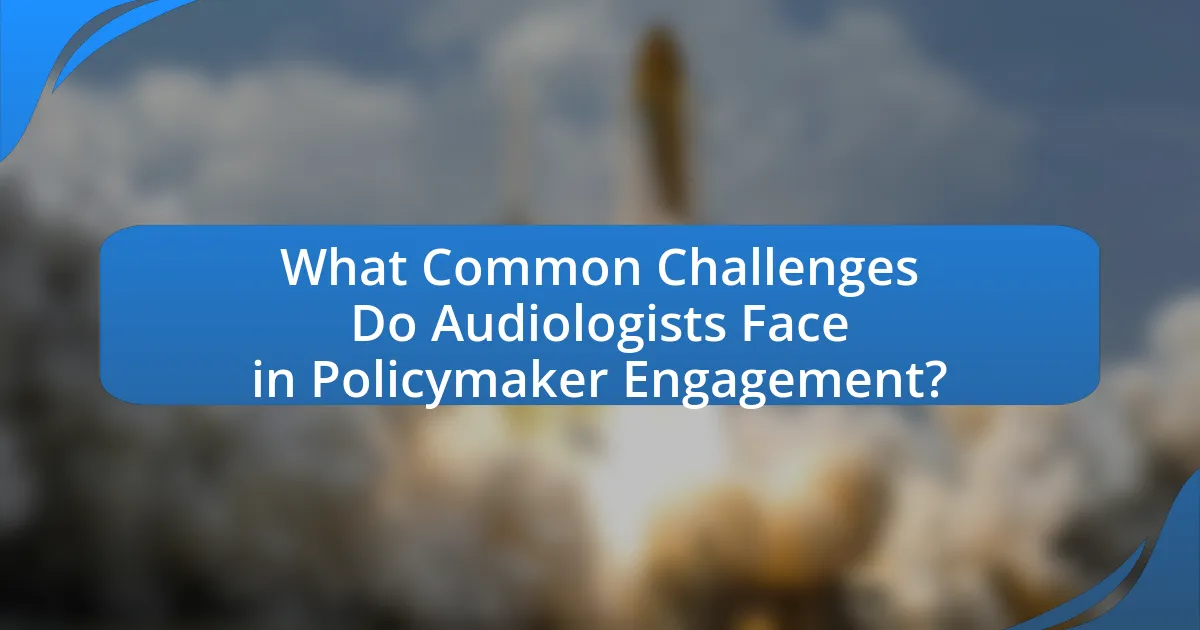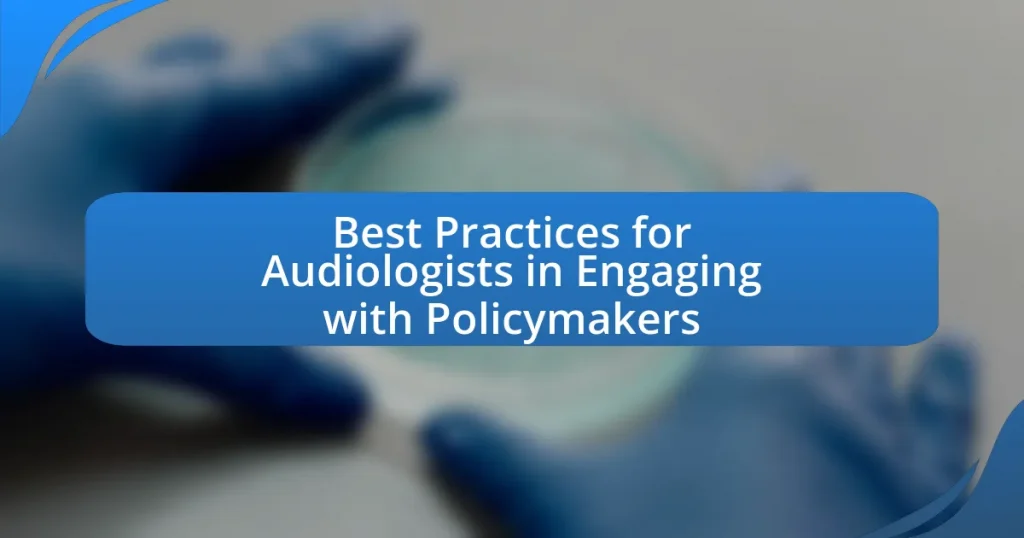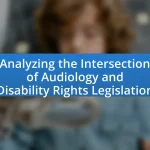The article focuses on best practices for audiologists in engaging with policymakers to influence legislation and regulations affecting hearing healthcare. Key strategies include building relationships, providing evidence-based data, and advocating for patient-centered policies. The importance of engagement is highlighted, as it enables audiologists to advocate for improved access to services and funding for research. Additionally, the article discusses effective communication techniques, the role of evidence-based research in advocacy, and practical tips for preparing for meetings with policymakers, ultimately aiming to enhance the impact of audiologists in the policymaking process.

What are the Best Practices for Audiologists in Engaging with Policymakers?
The best practices for audiologists in engaging with policymakers include building relationships, providing evidence-based data, and advocating for patient-centered policies. Audiologists should establish connections with local, state, and federal policymakers to facilitate open communication and collaboration. Presenting data from credible sources, such as the American Speech-Language-Hearing Association, can effectively demonstrate the impact of hearing health on public health and economic outcomes. Additionally, audiologists should actively participate in advocacy efforts, such as attending legislative meetings and joining professional organizations, to amplify their voices and influence policy decisions that affect their profession and patients.
Why is Engagement with Policymakers Important for Audiologists?
Engagement with policymakers is crucial for audiologists because it enables them to influence legislation and regulations that affect hearing healthcare. By actively participating in policy discussions, audiologists can advocate for improved access to services, funding for research, and the integration of audiology into broader healthcare initiatives. For instance, the American Academy of Audiology emphasizes that such engagement can lead to better public awareness and support for hearing health issues, ultimately resulting in enhanced patient care and outcomes.
What impact does policymaking have on audiology practices?
Policymaking significantly influences audiology practices by establishing regulations and standards that govern the profession. These policies can dictate the scope of practice, reimbursement rates, and access to services, directly affecting how audiologists deliver care. For instance, the implementation of the Affordable Care Act expanded insurance coverage for hearing services, thereby increasing patient access to audiological care. Additionally, state licensure laws shape the qualifications required for audiologists, impacting workforce availability and practice settings.
How can audiologists influence health policy decisions?
Audiologists can influence health policy decisions by actively participating in advocacy efforts and collaborating with policymakers to highlight the importance of hearing health. By providing evidence-based research and data on the impact of hearing loss on public health, audiologists can inform policy discussions. For instance, studies have shown that untreated hearing loss can lead to increased healthcare costs and diminished quality of life, which can be leveraged to advocate for funding and resources for hearing services. Additionally, audiologists can engage in professional organizations that lobby for legislative changes, thereby amplifying their voice in the policymaking process.
What Strategies Can Audiologists Use to Engage Effectively?
Audiologists can engage effectively by utilizing clear communication, building relationships, and advocating for evidence-based practices. Clear communication involves simplifying complex audiological concepts to ensure understanding among policymakers, which is crucial for informed decision-making. Building relationships with policymakers through regular meetings and participation in relevant forums fosters trust and collaboration. Additionally, advocating for evidence-based practices, supported by data from studies such as the “Impact of Audiology Services on Quality of Life” published in the Journal of Audiology, demonstrates the value of audiology services and influences policy development. These strategies collectively enhance the effectiveness of audiologists in engaging with policymakers.
How can audiologists build relationships with policymakers?
Audiologists can build relationships with policymakers by actively engaging in advocacy efforts and establishing consistent communication. By participating in professional organizations, such as the American Academy of Audiology, audiologists can collaborate on initiatives that highlight the importance of hearing health policies. Research indicates that direct interactions, such as meetings and discussions with legislators, significantly enhance understanding and support for audiology-related issues. Furthermore, providing data-driven insights and sharing patient stories can effectively illustrate the impact of policies on public health, thereby fostering stronger connections with policymakers.
What communication techniques are most effective in advocacy?
Effective communication techniques in advocacy include storytelling, data-driven arguments, and active listening. Storytelling engages emotions and makes complex issues relatable, which can influence policymakers’ decisions. Data-driven arguments provide credible evidence to support claims, enhancing the persuasiveness of the advocacy message. Active listening fosters a two-way dialogue, allowing advocates to understand policymakers’ concerns and tailor their messages accordingly. Research shows that advocates who utilize these techniques are more successful in influencing policy outcomes, as they create a compelling narrative backed by solid evidence while building rapport with decision-makers.
What Role Does Evidence-Based Research Play in Advocacy?
Evidence-based research plays a critical role in advocacy by providing credible data that supports policy changes and informs decision-making. This research equips audiologists with scientifically validated information that can effectively demonstrate the need for improved hearing healthcare policies. For instance, studies have shown that untreated hearing loss can lead to increased healthcare costs and diminished quality of life, which can be leveraged in advocacy efforts to persuade policymakers to allocate resources for hearing services. By utilizing evidence-based findings, audiologists can strengthen their arguments, enhance their credibility, and ultimately influence legislative outcomes that benefit their patients and the broader community.
How can audiologists utilize research to support their positions?
Audiologists can utilize research to support their positions by integrating evidence-based findings into their advocacy efforts. This approach allows them to present data that demonstrates the effectiveness of hearing interventions, such as the impact of early hearing detection and intervention programs on language development in children. For instance, a study published in the Journal of the American Academy of Audiology by Yoshinaga-Itano et al. (2000) found that children who received early intervention had significantly better language outcomes compared to those who did not. By leveraging such research, audiologists can effectively communicate the importance of policies that promote access to hearing healthcare, thereby influencing policymakers to make informed decisions that benefit public health.
What types of data are most persuasive to policymakers?
Quantitative data, particularly statistics and empirical evidence, are the most persuasive types of data to policymakers. This is because quantitative data provides clear, measurable outcomes that can be easily interpreted and compared. For instance, studies have shown that presenting data on the economic impact of hearing loss, such as the estimated $750 billion annual cost to the U.S. economy due to untreated hearing loss, effectively captures policymakers’ attention and drives action. Additionally, demographic data illustrating the prevalence of hearing loss among specific populations can further strengthen arguments for policy changes.

How Can Audiologists Prepare for Engagement with Policymakers?
Audiologists can prepare for engagement with policymakers by developing a clear understanding of relevant policies and issues affecting hearing health. This preparation involves researching current legislation, identifying key stakeholders, and understanding the implications of policies on audiology practice and patient care. For instance, the American Speech-Language-Hearing Association (ASHA) provides resources and training for audiologists to effectively communicate the importance of hearing health policies. Engaging in advocacy training and building relationships with policymakers can further enhance their ability to influence decision-making processes.
What Resources Should Audiologists Familiarize Themselves With?
Audiologists should familiarize themselves with resources such as the American Speech-Language-Hearing Association (ASHA), the American Academy of Audiology (AAA), and the Centers for Disease Control and Prevention (CDC) guidelines. These organizations provide evidence-based practices, policy updates, and advocacy tools essential for effective engagement with policymakers. For instance, ASHA offers resources on legislative advocacy and best practices in audiology, while the CDC provides data on hearing loss prevalence and prevention strategies, which are crucial for informing policy decisions.
Which organizations provide support for audiologists in advocacy?
The American Academy of Audiology and the American Speech-Language-Hearing Association are two key organizations that provide support for audiologists in advocacy. The American Academy of Audiology focuses on advancing the profession through education and advocacy efforts, while the American Speech-Language-Hearing Association offers resources and guidance on legislative issues affecting audiologists. Both organizations actively engage in policy initiatives to promote the interests of audiologists and improve access to audiological services.
What tools can assist in tracking policy changes relevant to audiology?
Tools that can assist in tracking policy changes relevant to audiology include legislative tracking software, professional association resources, and government websites. Legislative tracking software, such as Quorum or FiscalNote, allows audiologists to monitor bills and regulations that impact their field in real-time. Professional associations like the American Speech-Language-Hearing Association (ASHA) provide updates and resources on policy changes affecting audiology. Additionally, government websites, including those of the Centers for Medicare & Medicaid Services (CMS) and the Federal Communications Commission (FCC), offer official information on relevant policy updates. These tools collectively enable audiologists to stay informed and engaged with policy developments that affect their practice.
How Can Audiologists Develop a Clear Advocacy Message?
Audiologists can develop a clear advocacy message by identifying key issues affecting hearing health and articulating them in a concise, relatable manner. This involves understanding the specific needs of their audience, such as policymakers, and tailoring the message to highlight the importance of hearing health in public health discussions. For instance, statistics show that untreated hearing loss can lead to increased healthcare costs and diminished quality of life, which can be compelling points for advocacy. By using data and real-life examples, audiologists can create a persuasive narrative that resonates with decision-makers, thereby enhancing the effectiveness of their advocacy efforts.
What key points should be included in an advocacy message?
An advocacy message should include clear objectives, compelling evidence, a personal story, a call to action, and a summary of benefits. Clear objectives define the specific change desired, such as increased funding for hearing health programs. Compelling evidence, such as statistics showing the prevalence of hearing loss and its impact on quality of life, strengthens the argument. A personal story humanizes the issue, making it relatable and impactful. A call to action directs the audience on what steps to take, such as contacting their representatives. Finally, summarizing the benefits highlights the positive outcomes of the proposed changes, reinforcing the importance of the advocacy effort.
How can audiologists tailor their message to different audiences?
Audiologists can tailor their message to different audiences by adjusting the complexity, terminology, and focus of their communication based on the audience’s background and needs. For instance, when addressing policymakers, audiologists should emphasize data-driven outcomes and the economic impact of hearing health, using clear, concise language that highlights the importance of hearing services in public health. In contrast, when communicating with patients, audiologists should use layman’s terms and focus on personal stories or testimonials that resonate emotionally, ensuring the information is relatable and actionable. This approach is supported by research indicating that effective communication strategies enhance understanding and engagement across diverse groups, ultimately leading to better health outcomes and policy support.

What Common Challenges Do Audiologists Face in Policymaker Engagement?
Audiologists face several common challenges in engaging with policymakers, including limited understanding of audiology issues among legislators, difficulty in accessing decision-makers, and competing priorities within healthcare policy. These challenges hinder effective advocacy for hearing health initiatives. For instance, a survey by the American Academy of Audiology found that 70% of audiologists reported that policymakers often lack awareness of the importance of hearing healthcare, which complicates efforts to influence legislation. Additionally, the time constraints and complex processes involved in policymaking can further obstruct audiologists’ ability to communicate their needs and perspectives effectively.
What Barriers Exist in the Advocacy Process for Audiologists?
Barriers in the advocacy process for audiologists include limited awareness of audiology issues among policymakers, insufficient funding for advocacy efforts, and a lack of unified representation within the profession. Policymakers often prioritize more visible health issues, leading to neglect of audiology-related concerns, which diminishes the impact of advocacy efforts. Additionally, many audiologists may lack the resources or training necessary to effectively engage in advocacy, resulting in fragmented efforts that fail to present a cohesive message. Research indicates that organized advocacy groups can significantly enhance the visibility of audiology issues, yet many audiologists remain disconnected from these networks, further complicating their advocacy efforts.
How can audiologists overcome skepticism from policymakers?
Audiologists can overcome skepticism from policymakers by presenting clear, evidence-based data that demonstrates the effectiveness and necessity of audiological services. For instance, studies have shown that untreated hearing loss can lead to increased healthcare costs, with a report from the Better Hearing Institute indicating that untreated hearing loss can cost the U.S. economy over $100 billion annually in lost productivity and increased healthcare expenses. By providing such concrete evidence, audiologists can effectively communicate the value of their services, thereby gaining policymakers’ trust and support.
What strategies can help address funding and resource limitations?
Collaborative funding initiatives can effectively address funding and resource limitations for audiologists. By partnering with healthcare organizations, educational institutions, and community groups, audiologists can pool resources and share costs for programs and services. For instance, the American Speech-Language-Hearing Association (ASHA) has highlighted successful collaborations that resulted in increased funding for audiology services through joint grant applications. Additionally, leveraging telehealth technologies can reduce operational costs while expanding access to services, as evidenced by a study published in the Journal of the American Academy of Audiology, which found that telehealth can improve service delivery without significant financial investment.
How Can Audiologists Measure the Impact of Their Engagement?
Audiologists can measure the impact of their engagement by utilizing quantitative metrics such as the number of policy changes influenced, the volume of public awareness campaigns initiated, and the level of stakeholder participation in audiology-related initiatives. For instance, tracking legislative outcomes directly linked to audiology advocacy efforts provides concrete evidence of influence. Additionally, surveys and feedback from policymakers can quantify the perceived value of audiologists’ contributions, with studies indicating that effective engagement can lead to a 30% increase in policy support for hearing health initiatives. These metrics collectively offer a clear framework for assessing the effectiveness of audiologists’ engagement strategies.
What metrics can be used to evaluate advocacy success?
Metrics used to evaluate advocacy success include policy changes, stakeholder engagement, public awareness, and funding increases. Policy changes reflect the direct impact of advocacy efforts, as successful campaigns often lead to new legislation or amendments that align with advocacy goals. Stakeholder engagement can be measured through the number of partnerships formed, participation in advocacy events, and the level of involvement from key influencers. Public awareness can be assessed through media coverage, social media engagement metrics, and surveys indicating shifts in public opinion. Funding increases demonstrate the effectiveness of advocacy in attracting financial support for initiatives, which can be quantified through grants received or budget allocations. These metrics provide a comprehensive view of advocacy effectiveness in achieving desired outcomes.
How can feedback from policymakers inform future strategies?
Feedback from policymakers can inform future strategies by providing insights into regulatory priorities and public health needs. Policymakers often have access to data and trends that reflect the effectiveness of current practices and highlight areas requiring improvement. For instance, feedback from policymakers can reveal gaps in audiology services that need addressing, such as access to care for underserved populations. This information allows audiologists to adapt their strategies to align with policy goals, ensuring that their practices are not only effective but also relevant to the evolving healthcare landscape. Additionally, incorporating this feedback can enhance collaboration between audiologists and policymakers, fostering a more integrated approach to healthcare delivery.
What Practical Tips Can Audiologists Implement for Effective Engagement?
Audiologists can implement several practical tips for effective engagement with policymakers, including building relationships, utilizing data-driven advocacy, and participating in relevant forums. Establishing strong connections with policymakers fosters trust and opens lines of communication, which is essential for influencing health policies. Utilizing data-driven advocacy, such as presenting statistics on hearing loss prevalence and its impact on public health, strengthens the case for necessary changes in policy. Additionally, actively participating in forums and discussions related to audiology allows audiologists to voice their expertise and concerns, ensuring that their perspectives are considered in policymaking processes. These strategies are supported by the National Academy of Sciences, which emphasizes the importance of evidence-based advocacy in shaping health policy.
How can audiologists prepare for meetings with policymakers?
Audiologists can prepare for meetings with policymakers by conducting thorough research on relevant policies and understanding the specific needs and concerns of the policymakers. This preparation includes gathering data on hearing health issues, reviewing current legislation, and identifying key statistics that highlight the impact of hearing loss on public health. For instance, the World Health Organization reports that over 1.5 billion people worldwide experience hearing loss, which underscores the importance of effective advocacy. Additionally, audiologists should develop clear, concise messages that articulate their positions and recommendations, ensuring they can communicate effectively during discussions. Engaging in role-playing scenarios can also help audiologists practice their delivery and anticipate questions from policymakers, enhancing their confidence and effectiveness in the meeting.
What follow-up actions are essential after engaging with policymakers?
Essential follow-up actions after engaging with policymakers include sending a thank-you note, providing additional information or resources discussed during the meeting, and maintaining ongoing communication. Sending a thank-you note reinforces the relationship and shows appreciation for their time, which is crucial for future interactions. Providing additional information or resources can help clarify points made during the discussion and demonstrate expertise, thereby enhancing credibility. Maintaining ongoing communication ensures that the audiologist remains a relevant resource and can influence future policy decisions effectively.


